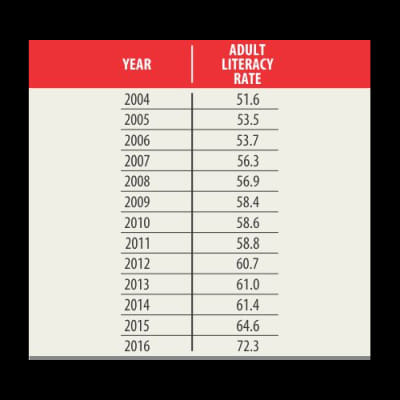Adult literacy rate hits 12-year high

Adult literacy rate in the country rose to a 12-year high of 72.3 percent last year.
The rate was 51.6 percent in 2004 and 64.6 percent in 2015, says a report titled “Sample Vital Registration System (SVRS)” prepared by Bangladesh Bureau of Statistics.
From 2004 to 2015, the average yearly increase in the literacy rate among people aged above 15 was between 0.2 and 3.3 percentage points.
The report, released in the last week of May, defines literacy of a person by the ability to write a simple letter.
Talking to The Daily Star, noted educationist Rasheda K Choudhury said, "I'm not clear about how literacy is defined here. If adult literacy is defined as someone's ability to write a simple letter, then what about the global definition of literacy?
"The Unesco's definition of literacy incorporates three things -- reading, writing and doing simple arithmetic. And I don't think this survey has followed this definition."
Rasheda, executive director of Campaign for Popular Education, however, said there has been a positive change in the literacy scenario because of the expansion of primary education in the country.
"The enrolment and completion rates at the primary level have increased in the last one decade," she said.
Contacted, AKM Ashraful Haque, project director of Monitoring the Situation of Vital Statistics of Bangladesh Project, said they followed the BBS definition of literacy for the study, and that could be a reason why a higher literacy rate was recorded.
Besides, the sample areas were increased to 2,012 in 2016 from 1,500 in the previous year, he added.
Ashraful also pointed out that the government's massive programmes for adult literacy was another reason behind the rise in the rate.
"Now it's hard to find a child who has not attended school. In rural areas, if children of a family don't go to school, NGOs find them out and take them to school."
Over the last few years, there has been a serious confusion over the actual literacy rate with ministers and government officials giving conflicting figures before the International Literacy Day observed on September 8.
Last year, Primary and Mass Education Minister Mostafizur Rahman said the literacy rate was 71 percent. It was 61 percent in the previous year.
RURAL-URBAN GAP
The report shows women lagged behind men in terms of attaining literacy, as 69.5 percent women were literate compared to 75.2 percent men.
The rural-urban gap in literacy was big. The adult literacy rate in rural areas stood at 65.4 percent against 80.7 percent in urban areas.
Barisal Division had the highest literacy rate of 83.5 percent among the population aged above 15 followed by Khulna Division with a literacy rate of 74.6 percent.
Rangpur division had the lowest literacy rate of 69.3 percent.
According to the report, literacy rate among the population aged seven and above was 71 percent in 2016 compared to 63.6 percent in the previous year. In 2004, the rate was 50 percent.


 For all latest news, follow The Daily Star's Google News channel.
For all latest news, follow The Daily Star's Google News channel. 



Comments